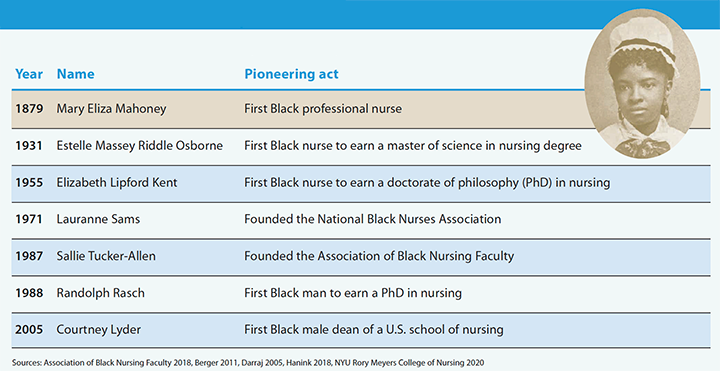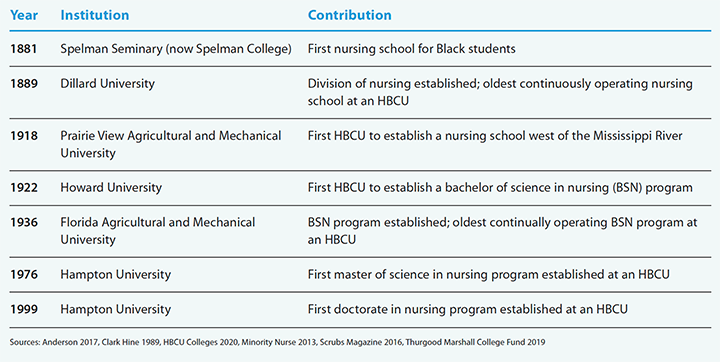Reflecting on the past and looking toward the future.
Takeaways:
- There is a need for increased Black nursing faculty and students in an effort to promote diversity within the profession and to decrease disparities among those receiving care.
- Black Americans made great strides in nursing education during the 20th century.
- Mentoring is an important aspect of recruitment and retention of Black nursing students and faculty.
By 2060, Black, Indigenous, and people of color (BIPOC) are expected to make up more than half of the American population under 18 years (Vespa and colleagues). As diversity increases, nurses must provide culturally competent care. Despite many calls to support BIPOC nurses and grant funding to assist with recruitment and retention, the racial disparities among nursing students and faculty are real, particularly among those who are Black.
Although Black Americans make up 13% of the U.S. population, only 11% of bachelor-level nursing students (American Association of Colleges of Nursing), 10% of RNs (Campaign for Action), and 9% of academic nurse educators (National League for Nursing, 2017) are Black. And according to the National Center for Education Statistics, only 40% of Black college students graduate from a 4-year degree program within the first 6 years of enrollment, compared to 74% of Asian students, 64% of White students, and 54% of Hispanic students. With the push to increase the number of nurses with a bachelor of science in nursing (BSN), college graduation rates are an important benchmark.
The lack of racial diversity may lead to feelings of isolation, misunderstandings, and lack of community among BIPOC nursing students and faculty. The need to focus on recruiting and retaining Black nursing students and faculty, in particular, is critical. This article provides insight into the historical relevance of Black nurses and institutions promoting nursing education for Black Americans, highlights the experiences that led the authors to become nurse educators, and offers suggestions for improving Black nursing student and faculty recruitment and retention.
Looking back
The low number of Black nurses in the United States isn’t a new phenomenon. Throughout the 19th century and first half of the 20th, Black students, nurses, and educators fought for equality. Mary Eliza Mahoney, the first Black professional nurse, and Estelle Massey Riddle Osborne, the first Black nurse to earn a master’s degree, are among several Black pioneers of nursing education who displayed courage and perseverance in the face of hostile political and social climates in the days after slavery, in the share-cropping era, and during implementation of Jim Crow laws. (See Black nurse educator pioneers.)
Black nurse educator pioneers
For centuries, Black nurses have been blazing a trail for today’s nurses.


Historically Black colleges and universities (HBCUs) also have been critical to educating Black nurses. For example, Hampton University created the first masters and doctoral programs for Black nurses, and Florida Agricultural and Mechanical University’s 85-year-old BSN program is the longest continually running BSN program for Black nurses. (See HBCU contributions.)
HBCU contributions
Currently, 101 historically Black colleges and universities (HBCUs)—down from 121 in the 1930s—operate in the United States. Of those, 41 have nursing programs. Less than 10% of all Black U.S. college students attend HBCUs, but these institutions educate 12.5% of Black chief executive officers, 40% of Black congresspeople and engineers, 50% of Black lawyers and professors at primarily White institutions, and 80% of Black local, state, and federal judges. The following HBCUs have made great strides in providing nursing education to Black students.


The need for diversity in nursing education
Cultural competency and humility don’t begin at the bedside; they begin in the classroom. Just as access to culturally diverse healthcare providers can lead to reductions in health disparities among minoritized groups, culturally diverse nursing faculty may help reduce disparities in nursing education and facilitate BIPOC student success. Racially diverse nursing faculty can leverage their unique lived experiences to foster inclusion and diversity among nursing students, resulting in improved patient care quality and overall health.
Racially isolating experiences, alienation, and overt or covert discrimination can create barriers—including lack of financial support, inadequate emotional and moral support, as well as insufficient academic advising, mentoring, technical help, and professional socialization—for student success. Cultural alienation may contribute to a perceived lack of support from White classmates and faculty, which leads to discomfort using available university resources. The result may be an inability to improve study habits and test-taking and time management skills. Although many of these barriers were present in the authors’ lives, we successfully graduated from our nursing programs and are now advocates for increased racial diversity in nursing education. (See Our reflections as Black nursing students and educators.)
Out reflections as Black nursing students and educators


As we reflect on the Black pioneers in nursing education and the educational institutions that provide professional development opportunities for Black undergraduate and graduate nursing students, we also reflect on the experiences that led us to become nurse educators. Three of the four authors attended public, primarily White institutions (PWIs) with 5% to 10% of our nursing class composed of Black students. The remaining author attended a private historically Black college and university (HBCU) where more than 95% of the students in her nursing class were Black.
Those of us who attended PWIs had fewer Black faculty members than the one who attended the HBCU. Two of us completed nursing school without ever having a Black nursing professor, and one was taught by only two Black tenure-track nursing professors. Some common themes of our nursing school experience include feelings of isolation and reaching out for support from non-Black faculty. This lack of representation among faculty and peers is what inspired us to become nurse educators.
Our colleague who attended the HBCU had a very different experience. She was assigned an upper-class mentor, regularly walked past a nursing hall of fame displaying photos of Black nurses, and most of her nursing professors were Black. Still, the lack of representation among Black nursing students and faculty at other U.S. universities and healthcare facilities sparked her desire to become a nurse educator.
Now, as master- and doctoral-prepared nurse educators, we are again experiencing a lack of representation among our nursing peers. Each of us has taught as clinical or course faculty at various PWIs in the eastern and western United States; one also has taught at an HBCU. We met while working at a university with more than 1,000 nursing students, but only five Black nursing faculty—three in the undergraduate program and two in the master’s program. This Black faculty-to-student ratio isn’t reflective of the geographic area in which the university is located, where more than 67% of local residents are Black. This type of racial disparity motivates us to be the best possible educators we can as well as advocates for increased recruitment and mentoring of Black nursing students and faculty.
Recruiting and retaining racially diverse nursing students
To attract diverse nursing students, colleges and universities must display a strong, clear, and genuine commitment to diversity. They also should identify and address cultural barriers and needs and hire faculty who are supportive and culturally sensitive to help prevent and counter intentional or unintentional discrimination. Addressing healthcare disparities requires that nursing faculty not only teach, but also serve as role models in the classroom; interact with patients, nurses, and other healthcare professionals in clinical practice; and conduct research relevant to the healthcare needs of minoritized, underserved populations.
Successful BIPOC student retention frequently faces challenges—such as inadequate academic preparation, lack of social adjustment to predominately White institutions, financial constraints, lack of faculty support, and low self-esteem—associated with socioeconomic and psychosocial status. Many schools of nursing have implemented retention strategies that offer mentorship, tracking systems for early identification of and intervention for at-risk students, scholarships, and strategies for student success. Yet, it’s the social and academic systems of the institution that influence student integration. It’s important to provide a formal environment of assistance that includes academic advising, mentorship programs, and peer support to create student allegiance to the institution, which in turn will increase the likelihood of academic and social success.
Successful students have the potential to become successful faculty, but recruiting Black faculty is an ongoing issue. Cultural biases, such as White faculty and students’ negative thoughts about Black faculty’s physical appearance and speech, can create barriers to recruitment and retention. This can cause Black faculty to express the same feelings of isolation as Black students. They also may lack proper work resources and experience toxic work environments in which they’re not respected by students, faculty, or administrators. Recruiting and retaining Black faculty will require changes in workplace culture and exclusivity, and mentoring is an important strategy for achieving those goals.
Mentoring
The literature is replete with articles on mentorship in nursing. However, few mentoring programs address or meet the specific needs of Black students. Some would argue that the needs of BIPOC students are no different from the needs of White students, so all mentoring programs should be created equally. However, many BIPOC students are at a disadvantage because of family issues; lack of academic preparedness, financial support, and role models; and little parental knowledge of nursing education processes. Nursing school faculty and administrators should promote mentoring programs that address those needs.
Mentorship programs with formal diversity and inclusivity plans, structured enrichment and academic support, and activities that promote integration and engagement within the school community can help ensure BIPOC student success. These programs also should provide open communication and accessibility, goals and challenges, and mutual respect and trust. Without mentoring programs tailored to meet diverse students’ needs, the attrition rate of undergraduate and graduate students will continue to grow, leading to a diminishing diverse workforce. The fewer diverse nursing students there are, the fewer diverse nurse educators there will be. And we’ll continue to face health disparities and inequalities related to an inability to meet the cultural needs of our increasingly diverse society.
Looking forward
We hope that the diversity of the nursing profession will soon be more representative of the diversity of the U.S. population in general and the geographic regions in which we live and work. When diverse nursing students interact with faculty who reflect the communities from which the students come, they thrive. When White nursing students hear the perspectives and experiences of BIPOC faculty, they have the opportunity to become more well-rounded, caring, and empathetic nurses. Increased diversity is beneficial to everyone. When diversity is at play, the sum is truly greater than its parts. AN
Access references at myamericannurse.com/?p=72286.
Tiffany M. Montgomery is a postdoctoral research fellow at Drexel University in Philadelphia, Pennsylvania. Jawanza R. Bundy is an assistant professor at Widener University in Chester, Pennsylvania. DeLisa Cofer is assistant dean of the Widener University School of Nursing. Erika M. Nicholls is a clinical practice leader at the Hospital of the University of Pennsylvania in Philadelphia.
References
American Association of Colleges of Nursing. Race/ethnicity of students enrolled from generic (entry-level) baccalaureate, RN-to-baccalaureate, total baccalaureate, master’s, research-focused doctoral, and DNP programs in nursing, 2010-2019. 2020. aacnnursing.org/Portals/42/News/Surveys-Data/EthnicityTbl.pdf
American Nurses Association. Minority Fellowship Program. emfp.org/
Anderson M. A look at historically black colleges and universities as Howard turns 150. Pew Research Center. February 28, 2017. pewresearch.org/fact-tank/2017/02/28/a-look-at-historically-black-colleges-and-universities-as-howard-turns-150
Association of Black Nursing Faculty. (2018). History of ABNF. abnf.net/vision-and-mission
Berger L. Trailblazer dishes it out. McKnight’s Long-Term Care News. February 1, 2011. mcknights.com/news/trailblazer-dishes-it-out
Bundy JR. Mentoring and parental involvement during the college-going process of first-generation African American students considering nursing education: a case study approach [dissertation]. Hampton, VA: Hampton University; 2016. proquest.com/docview/1879802598
Campaign for Action. Racial/ethnic composition of the RN workforce in the U.S. 2020. campaignforaction.org/resource/racialethnic-composition-rn-workforce-us/
Darnell LK, Hickson SV. Cultural competent patient-centered nursing care. Nurs Clin North Am. 2015;50(1):99-108. doi:10.1016/j.cnur.2014.10.008
Darraj SM. Mary Eliza Mahoney and the Legacy of African-American Nurses. Philadelphia, PA: Chelsea House Publishing; 2004.
Eller LS, Lev EL, Feurer A. Key components of an effective mentoring relationship: A qualitative study. Nurse Educ Today. 2014;34(5):815-20. doi:10.1016/j.nedt.2013.07.020
Falcon L. Breaking down barriers: First-generation college students and college success. Innovation Showcase. 2015;10(6). league.org/innovation-showcase/breaking-down-barriers-first-generation-college-students-and-college-success
Hanink E. African-American nurses who changed a nation. Working Nurse. workingnurse.com/articles/African-American-Nurses-Who-Changed-A-Nation
HBCU Colleges. HBCU schools offering nursing programs—2018 ranking. https://hbcu-colleges.com/nursing
Hine DC. Black Women in White: Racial Conflict and Cooperation in the Nursing Profession, 1890-1950. Bloomington, IN: Indiana University Press; 1989.
Lin KJ. Minority faculty role in retaining minority nursing students: An integrative review. IJNCC. 2018. scientonline.org/full-text/21761/Minority-Faculty-Role-in-Retaining-Minority-Nursing-Students:-An-Integrative-Review
Minority Nurse. Historically Black nursing schools: Yesterday and today. March 30, 2013. minoritynurse.com/historically-black-nursing-schools-yesterday-and-today
Mitchell KM, Chorney MA, Gural DM, Simmons-Swinden JM, Picheca L, Baxter CE. Social and academic integration strategies for retention of nursing students: A scoping review protocol. JBI Database System Rev Implement Rep. 2019;17(1):28-36.
Murray TA. Factors that promote and impede the academic success of African American students in prelicensure nursing education: An integrative review. J Nurs Educ. 2015;54(9):S74-81.
Murray TA, Pole DC, Ciarlo EM, Holmes S. A nursing workforce diversity project: Strategies for recruitment, retention, graduation, and NCLEX-RN success. Nurs Educ Perspect. 2016;37(3):138-43.
National Center for Education Statistics. Status and trends in the education of racial and ethnic groups. February 2019. nces.ed.gov/programs/raceindicators/indicator_red.asp
National Coalition of Ethnic Minority Nurse Associations. President emerita – Dr. Betty Smith Williams, PH, MN, MSN, RN, FAAN. ncemna.org/board-of-directors-2
National League for Nursing. Achieving diversity and meaningful inclusion in nursing education: A living document from the National League for Nursing. February 2016. nln.org/docs/default-source/about/vision-statement-achieving-diversity.pdf?sfvrsn=2
National League for Nursing. NLN Faculty Census Survey 2016-2017. nln.org/newsroom/nursing-education-statistics/nln-faculty-census-survey-2016-2017
NYU Rory Meyers College of Nursing. (2020). Awards: Estelle Osborne Award. https://nursing.nyu.edu/additional-materials/alumni-giving/awards
Pérez-Stable EJ, El-Toukhy S. Communicating with diverse patients: How patient and clinician factors affect disparities. Patient Educ Couns. 2018;101(12): 2186-94.
Salvucci C, Lawless CA. Nursing faculty diversity: Barriers and perceptions on recruitment, hiring and retention. J Cult Divers. 2016;23(2):65-75.
Scrubs Magazine. Historical moments for African American nurses. February 25, 2016. scrubsmag.com/historical-moments-for-african-american-nurses
Thurgood Marshall College Fund. About HBCUs. tmcf.org/about-us/member-schools/about-hbcus/
Valentin-Welch M. Evaluation of a national e-mentoring program for ethnically diverse student nurse-midwives and student midwives. J Midwifery Womens Health. 2016;61(6):759-67.
Vespa J, Medina L, Armstrong DM. Demographic Turning Points for the United States: Population Projections for 2020 to 2060. U.S. Census Bureau. February 2020. census.gov/content/dam/Census/library/publications/2020/demo/p25-1144.pdf
Whitfield-Harris L, Lockhart JS, Zoucha R, Alexander R. The lived experience of Black nurse faculty in predominantly White schools of nursing. J Transcult Nurs. 2017;28(6):608-15.



















2 Comments.
I love to hear enrollment increasing. However, diversity in nursing has no correlation to culturally competent care. Native born Indian Doctors are shown to get the best outcomes amongst African Americans. Every study has shown that ALL nurses and all people have biases based on looks, clothes etc. While there may be casual relationships with appearance and patient comfort that is not culturally competent care. Culturally competent care is the ability of a nurse to identify, plan and intervene for various cultural groups depending on date of immigration, culture, language, religious etc norms and if they Identify at all with any of those. Many minorities have been here long enough that they do not practice any customs of their home country.
I always teach/emphasize the major groups that we have locally in Metro Detroit in clinical.
Diversity is definitely correlated with culturally competent, humble, and compassionate care and better patient outcomes, including patient satisfaction. Yes, everyone has biases, but this article wasn’t about biases. It was about the need for equitable representation in nursing education and nursing practice. We provided plenty of evidence to assist those who want to increase the diversity of their nursing students and faculty.
Also, it sounds like you are equating diversity with immigration status. Most Black families in this country have been here for many generations—slavery began on U.S. soil before the country was founded or the constitution was written. Diversity includes cultures, practices, and beliefs of born and bred Americans.